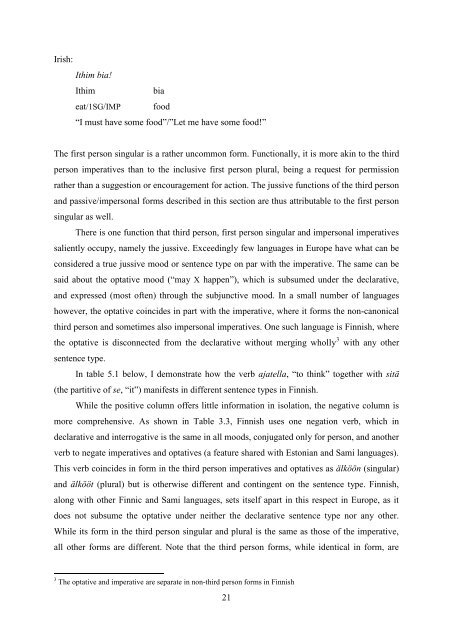The function of non-canonical imperatives in the languages of Europe
The function of non-canonical imperatives in the languages of Europe
The function of non-canonical imperatives in the languages of Europe
Create successful ePaper yourself
Turn your PDF publications into a flip-book with our unique Google optimized e-Paper software.
Irish:<br />
Ithim bia!<br />
Ithim<br />
bia<br />
eat/1SG/IMP food<br />
“I must have some food”/”Let me have some food!”<br />
<strong>The</strong> first person s<strong>in</strong>gular is a ra<strong>the</strong>r uncommon form. Functionally, it is more ak<strong>in</strong> to <strong>the</strong> third<br />
person <strong>imperatives</strong> than to <strong>the</strong> <strong>in</strong>clusive first person plural, be<strong>in</strong>g a request for permission<br />
ra<strong>the</strong>r than a suggestion or encouragement for action. <strong>The</strong> jussive <strong>function</strong>s <strong>of</strong> <strong>the</strong> third person<br />
and passive/impersonal forms described <strong>in</strong> this section are thus attributable to <strong>the</strong> first person<br />
s<strong>in</strong>gular as well.<br />
<strong>The</strong>re is one <strong>function</strong> that third person, first person s<strong>in</strong>gular and impersonal <strong>imperatives</strong><br />
saliently occupy, namely <strong>the</strong> jussive. Exceed<strong>in</strong>gly few <strong>languages</strong> <strong>in</strong> <strong>Europe</strong> have what can be<br />
considered a true jussive mood or sentence type on par with <strong>the</strong> imperative. <strong>The</strong> same can be<br />
said about <strong>the</strong> optative mood (“may X happen”), which is subsumed under <strong>the</strong> declarative,<br />
and expressed (most <strong>of</strong>ten) through <strong>the</strong> subjunctive mood. In a small number <strong>of</strong> <strong>languages</strong><br />
however, <strong>the</strong> optative co<strong>in</strong>cides <strong>in</strong> part with <strong>the</strong> imperative, where it forms <strong>the</strong> <strong>non</strong>-ca<strong>non</strong>ical<br />
third person and sometimes also impersonal <strong>imperatives</strong>. One such language is F<strong>in</strong>nish, where<br />
<strong>the</strong> optative is disconnected from <strong>the</strong> declarative without merg<strong>in</strong>g wholly 3 with any o<strong>the</strong>r<br />
sentence type.<br />
In table 5.1 below, I demonstrate how <strong>the</strong> verb ajatella, “to th<strong>in</strong>k” toge<strong>the</strong>r with sitä<br />
(<strong>the</strong> partitive <strong>of</strong> se, “it”) manifests <strong>in</strong> different sentence types <strong>in</strong> F<strong>in</strong>nish.<br />
While <strong>the</strong> positive column <strong>of</strong>fers little <strong>in</strong>formation <strong>in</strong> isolation, <strong>the</strong> negative column is<br />
more comprehensive. As shown <strong>in</strong> Table 3.3, F<strong>in</strong>nish uses one negation verb, which <strong>in</strong><br />
declarative and <strong>in</strong>terrogative is <strong>the</strong> same <strong>in</strong> all moods, conjugated only for person, and ano<strong>the</strong>r<br />
verb to negate <strong>imperatives</strong> and optatives (a feature shared with Estonian and Sami <strong>languages</strong>).<br />
This verb co<strong>in</strong>cides <strong>in</strong> form <strong>in</strong> <strong>the</strong> third person <strong>imperatives</strong> and optatives as älköön (s<strong>in</strong>gular)<br />
and älkööt (plural) but is o<strong>the</strong>rwise different and cont<strong>in</strong>gent on <strong>the</strong> sentence type. F<strong>in</strong>nish,<br />
along with o<strong>the</strong>r F<strong>in</strong>nic and Sami <strong>languages</strong>, sets itself apart <strong>in</strong> this respect <strong>in</strong> <strong>Europe</strong>, as it<br />
does not subsume <strong>the</strong> optative under nei<strong>the</strong>r <strong>the</strong> declarative sentence type nor any o<strong>the</strong>r.<br />
While its form <strong>in</strong> <strong>the</strong> third person s<strong>in</strong>gular and plural is <strong>the</strong> same as those <strong>of</strong> <strong>the</strong> imperative,<br />
all o<strong>the</strong>r forms are different. Note that <strong>the</strong> third person forms, while identical <strong>in</strong> form, are<br />
3 <strong>The</strong> optative and imperative are separate <strong>in</strong> <strong>non</strong>-third person forms <strong>in</strong> F<strong>in</strong>nish<br />
21
















